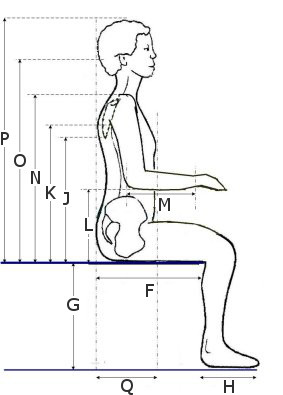Spinal Seating Modules

The purpose of specific body measurements
A well-fitted seating and wheeled mobility system requires a ‘made-to-measure’ solution. Generally, the more seating surface that is in contact with the client, the more body measurements need to be obtained for a wheelchair prescription.
Measurements for cushions
For all cushion trials and prescriptions, the mandatory body measurements required are:
- Hip width
- Thigh depth
- Lower leg length*
* The profile/height of the cushion can change the sitting surface height of the seating and mobility system. The foot support should be adjusted, based on lower leg length, in order for the cushion to provide optimum pressure distribution and pelvic stability.
Measurements for back supports
For all posterior/back support prescriptions, the mandatory body measurements required are:
- Hip width (for low backrest)
- Scapular height (for low backrest)
- Chest width (for higher back support)
Additional measurements for back support with thoracic lateral supports are:
- Chest depth
- Axilla height

Figure 1: Common linear body measures.
Original image from Zollars2, modified by C. Turnbull, used with permission. While A & B are nominally measured at the same place A is a measure of the external aspect of the skin/tissue and B is a measure of the underlying pelvic bone. It may be necessary to apply firm pressure to get an accurate reading.
Linear body measurements | MWC | PWC | Purpose | |
|---|---|---|---|---|
A | Hip width | ** | ** | To estimate cushion width, seat width or width between side hip supports |
B | GT width | - | - | To determine relevant cushion width for GT supports / offloading design cushions such as Jay 2 and Jay 2 deep contour cushions |
C | External knee width / width across knees | * | * | To adjust seat width or consider various styles footplate hanger/leg rest options |
D | Chest width | ** | * | To estimate distance between lateral trunk supports or select appropriate backrest width To review seat width of MWC - distance between the backcanes at thoracic height is equal/ greater than measure of client's chest width |
E | Shoulder width | * | * | To determine distance between arm supports if upper limb positioning and arm supports are required |
I | Foot width (also consider shoe width for tapered frame) | * | - | To determine minimum width for tapered frame/ single foot support size. (I X2 - for left and right) |
* Usefulness for this type of wheeled mobility
Please also refer to Module 5 - description of seating and wheeled mobility for terminology used in the ‘Purpose’ column.

Figure 2: Common linear body measures.
Original image from Zollars2, modified by C. Turnbull, used with permission.
Linear body measurements | MWC | PWC | Purpose | |
|---|---|---|---|---|
F | Thigh depth (most rearward point/sacrum to popliteal fossa) | ** | ** | To estimate seat depth by deducting: - ~25mm (1 inch) if thigh to lower leg angle is >90o - ~50mm (2 inches) if thigh to lower leg angle is <90o (prevent seat base contacting calf muscles) |
G | Lower leg length | ** | ** | To estimate distance between wheelchair front seat surface to foot support, deduct cushion height from “G”, and add shoe height |
H | Foot depth: | * | * | To select foot support /footplate style, size & accessories, considering the impact of footplate interference on front castor spins |
J | Scapula height: | * | - | To estimate maximum back support height to cushion/sitting surface for unhindered scapulae movement in MWC propulsion |
K | Axilla height: | * | * | The maximum height of the lateral trunk supports from cushion/sitting surface should be 25mm (1 inch) less than this measurement to prevent impingement of axillary nerve. |
L | Elbow height: | * | ** | To estimate arm support or lap tray height from seat surface |
M | Forearm Depth | * | ** | To estimate armrest pad size and approximate joystick mounting position. |
N | Shoulder height | - | * | Approximated backrest height from cushion/sitting surface for : -those who use tilt / recline for pressure management -for the mounting of anterior shoulder / trunk support to provide effective line of pull. |
O | Occipital height: | - | * | To note head support height from sitting surface - particularly important for those with poor head control/use significant amount of tilt |
P | Maximum sitting height: | * | * | Consider clearance above the head while entering /being transported in vehicles. Overall head to floor height = P + cushion height at ITs + seat to floor height |
Q | Trunk depth: | - | - | To provide optimum support, the depth of lateral trunk supports should be ~ approx. 2/3 of trunk depth for ‘dependant sitters’ |
* Usefulness for this type of wheeled mobility
References
- Babinec M., 2014. Translating evaluation measurements to wheelchair dimensions. Invacare United States. Online article: https://cdn2.hubspot.net/hub/287403/file-663602043-pdf/Get_Back_In_Game/13-488_WC_Measurement_Guide.pdf Accessed 25/02/16.
- Zollars, J.A., (Illus. Knezevich, J.), 1996. Special seating: An illustrated guide. Otto Bock Orthopaedic Indus., Inc., pp120.